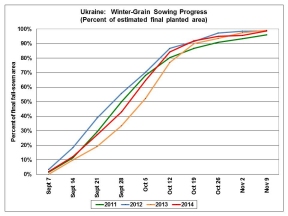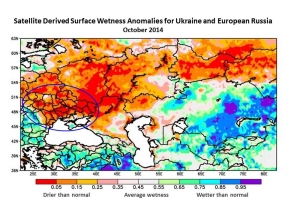Ukraine: Establishment Conditions for 2015/16 Winter Grains
 According to data from the Ukrainian Ministry of Agricultural Policy and Food and estimates from the USDA Foreign Agricultural Service, 2015/16 winter grains were planted on 8.03 million hectares compared to 7.79 million last year. The total includes an estimated 0.4 million hectares of winter grains in Crimea based on Rosstat planting reports and historical data from the State Statistical Committee of Ukraine. Wheat was planted on approximately 6.75 million hectares (against 6.34 million last year), barley on 1.13 (1.25) million, and rye on 0.15 (0.20) million. An additional 0.82 million hectares of winter rape was planted in Ukraine compared to 0.95 million last year. Generally dry weather throughout the fall sowing campaign enabled winter crops to be planted without undue delay. According to data from the Ukrainian Ministry of Agricultural Policy and Food and estimates from the USDA Foreign Agricultural Service, 2015/16 winter grains were planted on 8.03 million hectares compared to 7.79 million last year. The total includes an estimated 0.4 million hectares of winter grains in Crimea based on Rosstat planting reports and historical data from the State Statistical Committee of Ukraine. Wheat was planted on approximately 6.75 million hectares (against 6.34 million last year), barley on 1.13 (1.25) million, and rye on 0.15 (0.20) million. An additional 0.82 million hectares of winter rape was planted in Ukraine compared to 0.95 million last year. Generally dry weather throughout the fall sowing campaign enabled winter crops to be planted without undue delay.
The fall dryness that facilitated timely planting also hampered winter-crop emergence and establishment. Moisture conditions for emerging crops were substantially worse than last year throughout the country. Microwave satellite imagery indicates that topsoil wetness was persistently below normal from early September through late November, especially in eastern Ukraine. Vegetative indices (NDVI) derived from MODIS satellite imagery are consistent with the microwave imagery and indicate that winter-crop establishment is noticeably worse than last year. The NDVI from early November, when winter grains were in the tillering stage, were below normal and worse than last year in nearly all territories in Ukraine and were particularly low in Kirovograd, Nikolayev, and Odessa oblasts in southern Ukraine. A December 4  report from the Ministry of Agricultural Policy and Food cites that 18 percent of the country’s winter crops are in weak condition compared to 8 percent at roughly the same time last year. Daily temperature data indicate that vegetative growth of winter crops had concluded by early December throughout the country and that crops were entering dormancy or were fully dormant in the northern and central regions. report from the Ministry of Agricultural Policy and Food cites that 18 percent of the country’s winter crops are in weak condition compared to 8 percent at roughly the same time last year. Daily temperature data indicate that vegetative growth of winter crops had concluded by early December throughout the country and that crops were entering dormancy or were fully dormant in the northern and central regions.
Although winter crops certainly benefit from favorable conditions during establishment, crops can partially recover from fall dryness if growing conditions are favorable when vegetative growth resumes in the spring. Winter wheat in particular is a remarkably resilient crop. Spring and early-summer weather remains the most important yield determinant for winter crops.
Initial USDA estimates of 2015/16 crop production will be released on May 12, 2015. Current USDA area and production estimates for grains and other agricultural commodities are available on IPAD’s Agricultural Production page, or at PSD Online.
|

